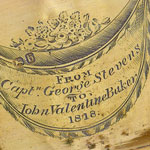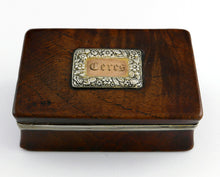East Indiaman ‘Ceres’ - Presentation Snuff Box, Circa 1818
Adding product to your cart
9cm (3.5in) x 5.4cm (2.2in) x 2.8cm (1.2in)
Oak, silver gilt mounted snuff box of rectangular form and bearing the a plaque with foliate border to the lid inscribed ‘Ceres’. The silver gilt lined interior bearing presentation engraving ‘From / Captn. George Stevens / For / John Valentine Baker / 1818’. Maker’s mark of William Eley. Hallmarked London 1817.
Read more
The present snuff box belongs to the naval tradition of constructing such items from ships timbers as a momento of service at sea. This example is constructed from the timbers Ceres [IV], an armed East Indiaman of 1430 tons, built at Blackwall, launched in 1796 and that continued in service until 1816. In 1797 Captain George Stevens and John Valentine Baker, both of the Honourable East India Company’s Maritime Service, were confirmed as Commander and Third Officer respectively for the year and half long voyage to the Bay of Bengal and China, that departed Portsmouth on 6 April 1797 under conditions of war and returned to moorings on 22 October 1798. Ceres [IV] was nominally owned by Thomas Newte of Bampton, Devon who was married to a shipping and banking heiress from Essex.
The East India Company generally chartered rather owned the ships that exercised its tightly controlled monopoly on trade east of Bengal. In total there were four East Indiamen named Ceres (for the Roman goddess of agriculture). The second of these, launched 1787 and armed with 28 guns, was also nominally operated by Newte. It was also captained on its second and third voyages to China by Stevens. During the last of these, made after the outbreak of war with revolutionary France, the H.E.I.C. arranged for Ceres [II] to sail under a letter of marque (issued to Stevens on 22 April 1793), as part of a large convoy that included military and merchant vessels bound for the Mediterranean as well as other a dozen other East Indiamen.
On 24 June 1793 the fleet of Indiamen captured the French brig Franc, with the crew of Ceres [II] taking possession, before proceeding to Whampoa. On her return to home waters via St Helena in September 1794, Ceres [II] was bought by the Admiralty to meet the Royal Navy’s need for small two-decker fourth rates to serve as convoy escorts. Ceres [II] was renamed H.M.S. Grampus, there already being an H.M.S. Ceres in the Royal Navy. After career of mixed fortunes Grampus grounded on Barking Shelf and was deliberately destroyed by fire in 1799. A Ceres [III] operated between 1795 and 1802 but at 442 tons was only chartered by the East India Company as an ‘Extra Ship’ to handle occasional excess cargoes. Ceres [I], [II] and [IV] were ‘Regular Ships’ and thus regularly chartered.
Sworn officers such as Baker and Stevens were allowed to trade on their own behalf and, to facilitate this, were given a set percentage of space in the hold for the carriage of their own goods. If they did not use it all they could sell it on, usually to the Company but also to each other. This enabled them to compensate for meagre Company wages and permitted many to accumulate substantial fortunes. As an E.I.C. Commander of Regular Ships, Stevens and later Baker enjoyed high rank and status whether on land, at sea or leaving or entering port. Such status was reflected in how many guns were fired in salute to them and how many guns they should fire in respect of other officers or E.I.C. employees.
Meanwhile Thomas Newte’s new Ceres [IV] carried on the still lucrative business of carrying East India Company cargoes outward to the east, returning richly laden with exotic goods to Europe in the grip of Napoleon’s Continental System. As John Valentine Baker progressed up the ladder to the command in other East Indiamen, Stevens sailed again in convoy for China in Ceres [IV] in March 1800, returning home in June 1801. By the time of Ceres last voyage St Helena, Bencoolen and China in 1812-14, she was under the command of Captain Hugh Scott with George Stevens, Esq. named as ‘ship husband’, i.e. operating owner. William John Huggins’ painting of Ceres on her final voyage shows the East Indiaman off St Helena ‘in two different views’, a technique often used by marine artists to demonstrate an understanding of sailing.
Ceres [IV] was broken up in 1816, and George Stevens who had been first sworn in as commander of Ceres [II] in 1787, settled at Old Windsor Lodge, Berkshire. He married Sarah, later of The Park, Cheltenham, and had a daughter, Georgiana, who married Stephen Martin Leake (1826-1893), legal writer (ODNB).






